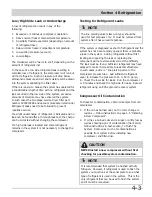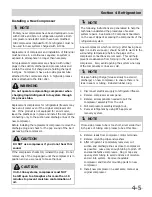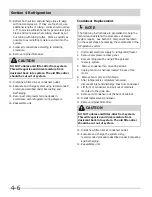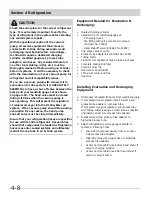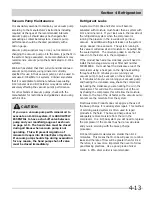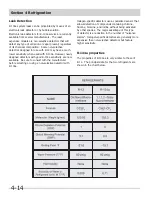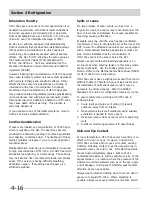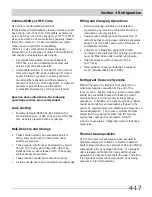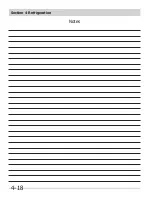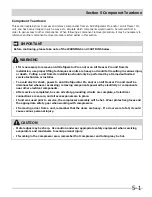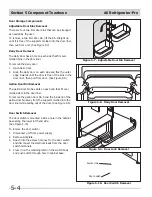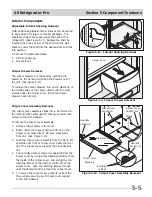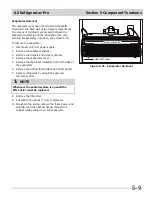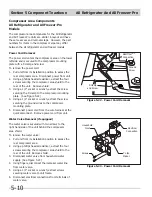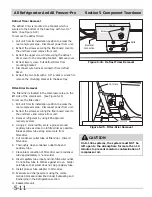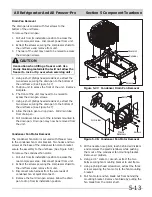
Section 4 Refrigeration
4-16
Inhalation Toxicity
HFC-134a poses no acute or chronic hazard when it is
handled in accordance with DuPont recommendations
and when exposures are maintained at or below the
DuPont Acceptable Exposure Limit (AEL) of 1,000 ppm
(8 and 12 hour Time-Weighted Average or TWA).
An AEL is an airborne exposure limit established by
DuPont scientists that specifies time-weighted average
(TWA) airborne concentrations to which nearly all
workers may be repeatedly exposed without adverse
effects. The AEL for HFC-134a has the same value as
the Threshold Limit Values (TLVs) established for
CFC-12 and HCFC-22. TLVs are established by the
American Conference of Governmental and Industrial
Hygienists (ACGIH).
However, inhaling high concentrations of HFC-134a vapor
may cause temporary central nervous system depression
with narcosis, lethargy and anesthetic effects. Other
effects that may occur include dizziness, a feeling of
intoxication and a loss of coordination. Continued
breathing of high concentrations of HFC-134a vapors
may produce cardiac irregularities (cardiac sensitization),
unconsciousness, and with gross overexposure, death.
Intentional misuse or deliberate inhalation of HFC-134a
may cause death without warning. This practice is
extremely dangerous.
If you experience any of the initial symptoms, move to
fresh air and seek medical attention.
Cardiac Sensitization
If vapors are inhaled at a concentration of 75,000 ppm,
which is well above the AEL, the heart may become
sensitized to adrenaline, leading to cardiac irregularities
and, possibly, to cardiac arrest. The likelihood of these
cardiac problems increases if you are under physical or
emotional stress.
Medical attention must be given immediately if exposed
to high concentrations of HFC-134a. DO NOT treat with
adrenaline (epinephrine) or similar drugs. These drugs
may increase the risk of cardiac arrhythmia and cardiac
arrest. If the person is having difficulty breathing,
administer oxygen. If breathing has stopped, give
artificial respiration.
Spills or Leaks
If a large release of vapor occurs, such as from a
large spill or leak, the vapors may concentrate near the
floor or low spots and displace the oxygen available for
breathing, causing suffocation.
Evacuate everyone until the area has been ventilated.
Use blowers or fans to circulate the air at floor level. DO
NOT re-enter the affected area unless you are equipped
with a self-contained breathing apparatus or unless an
area monitor indicates that the concentration of
HFC-134a vapors in the area is below the AEL.
Always use self-contained breathing apparatus or an
air-line mask when entering tanks or other areas where
vapors might exist. Use the buddy system and a
lifeline. Refer to the Material Safety Data Sheet (MSDS)
for HFC-134a for more information.
HFC-134a vapors have a slightly sweet odor that can be
difficult to detect. Therefore, frequent leak checks and
the installation of permanent area monitors may be
necessary in enclosed spaces. Refer to ASHRAE
Standards 15 and 34 for refrigeration machinery rooms.
To ensure safety when working with HFC-134a in
enclosed areas:
1. Route relief and purge vent piping (if present)
outdoors, away from air intakes.
2. Make certain area is well ventilated, using auxiliary
ventilation if needed to move vapors.
3. Make sure area is clear of vapors prior to beginning
work.
4. Install air monitoring equipment to detect leaks.
Skin and Eye Contact
At room temperature, HFC-134a vapors have little or no
effect on the skin or eyes. However, in liquid form,
HFC-134a can freeze skin or eyes on contact, causing
frostbite. Following contact, soak the exposed area in
lukewarm water, not cold or hot. If medical treatment
cannot begin immediately, apply a light coat of a
nonmedicated ointment, such as petroleum jelly. If the
exposed area is in a location where the presence of the
ointment would be awkward, such as on the eye, apply
a light bandage. In all cases of frostbite, seek medical
attention as soon as possible.
Always wear protective clothing when there is a risk of
exposure to liquid HFC-134a. Where splashing is
possible, always wear eye protection and a face shield.
Содержание FPUH17D7KF All Freezer Professional Series
Страница 2: ......
Страница 20: ...Section 2 Installation Information 2 12 Figure 2 20 Figure 2 21 ...
Страница 21: ...Section 2 Installation Information 2 13 Figure 2 22 Figure 2 23 ...
Страница 24: ...Section 2 Installation Information 2 16 Notes ...
Страница 26: ...Section 3 Electronic Control 3 2 Notes ...
Страница 41: ...Section 4 Refrigeration 4 15 HFC 134a CFC 12 Pressure Temperature Chart ...
Страница 44: ...Section 4 Refrigeration 4 18 Notes ...
Страница 68: ...Section 6 Parts List 6 2 All Refrigerator Cabinet Exploded View And Parts List ...
Страница 70: ...Section 6 Parts List 6 4 All Refrigerator Sealed System Exploded View And Parts List ...
Страница 72: ...Section 6 Parts List 6 6 All Freezer Door Exploded View And Parts List ...
Страница 74: ...Section 6 Parts List 6 8 All Freezer Cabinet Exploded View And Parts List ...
Страница 76: ...Section 6 Parts List 6 10 All Freezer Sealed System Exploded View And Parts List ...
Страница 78: ...Section 6 Parts List 6 12 Notes ...
Страница 82: ...Section 7 Troubleshooting 7 4 Notes ...
Страница 83: ...Section 8 Wiring Diagram 8 1 All Refrigerator Wiring Diagram ...
Страница 84: ...8 2 Section 8 Wiring Diagram All Freezer Wiring Diagram ...


